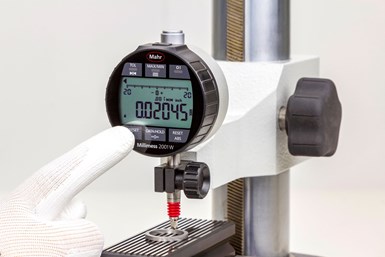Performance Digital Comparators Offer an Alternative to Bench Amplifiers
Electronics today allow for matching the linear variable differential transformer performance and digital indicator size into a new digital comparator that provides even more value than traditional bench amplifiers.
Share





.png;maxWidth=45)
DMG MORI - Cincinnati
Featured Content
View More

Autodesk, Inc.
Featured Content
View More

ECi Software Solutions, Inc.
Featured Content
View MoreIn many ways, digital indicators are becoming so powerful that they are taking on the performance and features of bench amplifiers. It is not uncommon to find features such as dynamic measurements, multiple factors, unilateral tolerances, different output formats and sub-micron resolutions in higher-end digital indicators.
However, if there was a weakness in digital indicators, it usually came from system performance. This is because most longer-range digital indicators are built upon scale technology, which is great for most applications around the shop. But when it comes to parts with extremely tight tolerances, there is no match for a linear variable differential transformer-based (LVDT) bench amplifier system or an LVDT-based digital comparator.
The combination of a ball bushing LVDT-based transducer built into the display of a digital indicator offers a much less expensive solution to a bench amplifier-based system. This provides a very powerful indicating device to replace an aging bench amplifier or to upgrade a dial indicator for a cost-effective price.
With the new bench amplifier performance, one might think there would be a technology shock to those users used to reading a basic dial indicator or digital indicator, but this may not be the case. One aid for this may be to take control of this flexibility from the operator by setting up passwords or codes as part of the digital indicator's setup process or even by having the digital comparator set up for the specific task remotely via a link to a small PC program to set measuring conditions and tolerances. The idea is that once the digital indicator is set up with its tolerances, measuring direction, resolution, measuring mode, multiplier and so on, the password would lock the operator out from accidentally changing the setup of the indicator and potentially affect the measurement results.
Another point to consider would be placing these high-performance digital comparators on the shop floor in the working environment. The digital indicator can take a beating because re-zeroing is often recommended, or dynamic reset buttons are used for every measurement. Even painted or stamped markings can eventually rub off or be removed by solvents at the point of manufacture.
But here is where the metrology industry borrows from the technology in today’s electronics. Just as many smartphones are made from glass, a new generation of digital comparators follows the same path.
As scary as one might think, putting a glass indicator on the shop floor is actually a good idea. In many ways, there are a lot of potential advantages. Whether in phones or tablets, today's glass products are extremely tough. Maybe dropping them is not a good idea, but under normal use, one can get a lifetime of button pushes on a glass screen without degrading performance.
The same applies when a glass bezel is employed on a digital comparator. Since the glass itself is the “touch screen” of the indicator, there are no mechanical buttons or switches to wear out over time. No buttons also mean fewer areas for contamination. And because the button labeling is under the glass face, there is no chance for the labeling of the button to wear off.
But the more significant improvement could be the ease of use, even when the operator uses gloves at the point of manufacture. Certain glass screens do not need an actual finger touch but can be switched or selected even while wearing gloves. In addition, the screen is sensitive to the user even in the harshest conditions.
There has been no match for the LVDT-based bench amplifier in the past for providing the most accurate and powerful gaging results from the measuring station. However, electronics today allow for matching the LVDT performance and digital indicator size into a new digital comparator that provides even more value.
Related Content
Parts and Programs: Setup for Success
Tips for program and work setups that can simplify adjustments and troubleshooting.
Read MoreHow to Calibrate Gages and Certify Calibration Programs
Tips for establishing and maintaining a regular gage calibration program.
Read MoreChoosing the Correct Gage Type for Groove Inspection
Grooves play a critical functional role for seal rings and retainer rings, so good gaging practices are a must.
Read MoreThe Many Ways of Measuring Thickness
While it may seem to be a straightforward check, there are many approaches to measuring thickness that are determined by the requirements of the part.
Read MoreRead Next
5 Rules of Thumb for Buying CNC Machine Tools
Use these tips to carefully plan your machine tool purchases and to avoid regretting your decision later.
Read MoreRegistration Now Open for the Precision Machining Technology Show (PMTS) 2025
The precision machining industry’s premier event returns to Cleveland, OH, April 1-3.
Read MoreBuilding Out a Foundation for Student Machinists
Autodesk and Haas have teamed up to produce an introductory course for students that covers the basics of CAD, CAM and CNC while providing them with a portfolio part.
Read More








.png;maxWidth=150)





















.jpg;maxWidth=300;quality=90)


.jpg;maxWidth=300;quality=90)














